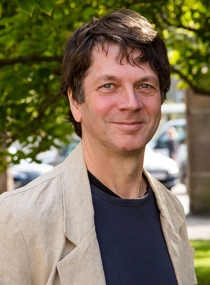Thomas Heimburg appointed Professor
Thomas Heimburg, head of the Membrane Biophysics Group at the Niels Bohr Institute, has been appointed professor of theoretical and experimental biophysics. He researches how the signals of nerve pathways function using waves in the form of a sound pulse, a soliton.

Thomas Heimburg, head of the Membrane Biophysics Group at the Niels Bohr Institute, has been appointed professor of theoretical and experimental biophysics.
Thomas Heimburg was born in London, where the family was living because of his father’s research position, but when Thomas was 1½ years old, the family moved back to Stuttgart, Germany. Why he became a biophysicist was – as is often the case, a series of coincidences. When he was asked as a 15-16 year old in school what he wanted to be, he replied: Biophysicist. This was drawn from thin air, because he had no idea that the field existed, but he had made up the word from biology and physics, which were his favourite subjects in school. But he found out that it really existed and he then went to the University of Stuttgart, where they conducted research in biophysics, to find out what it was all about. There he learned that they dissected animals like frogs and rats and studied the nerves. He certainly did not want to do that, so when he had to choose what to study, he chose theoretical physics.
He received his degree in physics from the University of Stuttgart and the University Göttingen and in 1989 he received his PhD from the Max Planck Institute in Göttingen. Then he was a postdoc at the University of Virginia in Charlottesville, USA for two years and this had a big influence on his later work.
“The University of Virginia was very well known for their research on biophysical thermodynamics and I quickly became so hooked on this research field that it became the foundation for my future work,” explains Thomas Heimburg.
Back home in Germany, Thomas Heimburg received the very prestigious Heisenberg Grant, which allowed him to build up his own research group in biophysics at the Max Planck Institute in Göttingen.
Professor of biophysics
In 2003, he joined the Niels Bohr Institute, where he carries out research in physics and on the thermodynamics in biological membranes and nerves. Because how do nerve signals work? In 1952, Hodgkin and Huxley put forth their model describing nerve signals as an electric current along the nerve pathway via an ion mechanism. Everyone believed in this model and, for more than 60 years, all medical and biological textbooks have stated that nerves function by electric current along the nerve pathway
In 2005, Thomas Heimburg, in collaboration with Professor Andrew Jackson, proposed a theory that nerves function by sound pulses. But when eminent researchers have received the Nobel Prize for the theory about electric current, it can be very difficult to claim otherwise. But Thomas Heimburg and his research group have conducted experiments confirming the theory of sound pulses as nerve signals.
“The impulse of the nerve pathway can be explained by the pulse being comprised of mechanical waves in the form of a sound pulse, a soliton, which travels along the membrane of the nerve pathway,” explains Thomas Heimburg, who now works with nerves from earthworms and lobsters – what he thought sounded so awful as a young man, he is certainly ok with now. Now this work has led to a professorship in biophysics.
